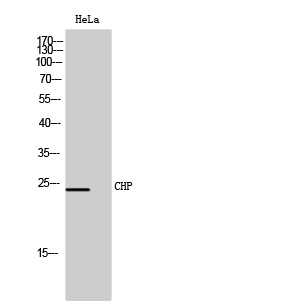CHP Polyclonal Antibody
- Catalog No.:YT0914
- Applications:WB;ELISA
- Reactivity:Human;Mouse;Rat
- Target:
- CHP
- Gene Name:
- CHP1
- Protein Name:
- Calcineurin B homologous protein 1
- Human Gene Id:
- 11261
- Human Swiss Prot No:
- Q99653
- Mouse Gene Id:
- 56398
- Mouse Swiss Prot No:
- P61022
- Rat Gene Id:
- 64152
- Rat Swiss Prot No:
- P61023
- Immunogen:
- Synthesized peptide derived from the Internal region of human CHP.
- Specificity:
- CHP Polyclonal Antibody detects endogenous levels of CHP protein.
- Formulation:
- Liquid in PBS containing 50% glycerol, 0.5% BSA and 0.02% sodium azide.
- Source:
- Polyclonal, Rabbit,IgG
- Dilution:
- WB 1:500 - 1:2000. ELISA: 1:20000. Not yet tested in other applications.
- Purification:
- The antibody was affinity-purified from rabbit antiserum by affinity-chromatography using epitope-specific immunogen.
- Concentration:
- 1 mg/ml
- Storage Stability:
- -15°C to -25°C/1 year(Do not lower than -25°C)
- Other Name:
- CHP1;CHP;Calcineurin B homologous protein 1;Calcineurin B-like protein;Calcium-binding protein CHP;Calcium-binding protein p22;EF-hand calcium-binding domain-containing protein p22
- Observed Band(KD):
- 24kD
- Background:
- This gene encodes a phosphoprotein that binds to the Na+/H+ exchanger NHE1. This protein serves as an essential cofactor which supports the physiological activity of NHE family members and may play a role in the mitogenic regulation of NHE1. The protein shares similarity with calcineurin B and calmodulin and it is also known to be an endogenous inhibitor of calcineurin activity. [provided by RefSeq, Jul 2008],
- Function:
- function:Required for constitutive membrane traffic. Inhibits GTPase-stimulated Na(+)/H(+) exchange. Also inhibits calcineurin phosphatase activity. Required for activity of SLC9A1/NHE1.,PTM:Both N-myristoylation and calcium-mediated conformational changes are essential for its function in exocytic traffic.,PTM:Phosphorylated; decreased phosphorylation is associated with an increase in exchange activity. The phosphorylation state may regulate the binding to NHE1.,similarity:Contains 4 EF-hand domains.,subunit:Monomer (By similarity). Specifically binds to SLC9A1/NHE1 at a domain that is critical for growth factor stimulation of exchange activity.,tissue specificity:Ubiquitously expressed. Has been found in fetal eye, lung, liver, muscle, heart, kidney, thymus and spleen.,
- Subcellular Location:
- Nucleus . Cytoplasm . Cytoplasm, cytoskeleton . Endomembrane system . Endoplasmic reticulum-Golgi intermediate compartment . Endoplasmic reticulum . Cell membrane . Membrane ; Lipid-anchor . Localizes in cytoplasmic compartments in dividing cells. Localizes in the nucleus in quiescent cells. Exported from the nucleus to the cytoplasm through a nuclear export signal (NES) and CRM1-dependent pathway. May shuttle between nucleus and cytoplasm. Localizes with the microtubule-organizing center (MTOC) and extends toward the periphery along microtubules. Associates with membranes of the early secretory pathway in a GAPDH-independent, N-myristoylation- and calcium-dependent manner. Colocalizes with the mitotic spindle microtubules. Colocalizes with GAPDH along microtubules. Colocalizes with SLC9A1
- Expression:
- Ubiquitously expressed. Has been found in fetal eye, lung, liver, muscle, heart, kidney, thymus and spleen.
- June 19-2018
- WESTERN IMMUNOBLOTTING PROTOCOL
- June 19-2018
- IMMUNOHISTOCHEMISTRY-PARAFFIN PROTOCOL
- June 19-2018
- IMMUNOFLUORESCENCE PROTOCOL
- September 08-2020
- FLOW-CYTOMEYRT-PROTOCOL
- May 20-2022
- Cell-Based ELISA│解您多样本WB检测之困扰
- July 13-2018
- CELL-BASED-ELISA-PROTOCOL-FOR-ACETYL-PROTEIN
- July 13-2018
- CELL-BASED-ELISA-PROTOCOL-FOR-PHOSPHO-PROTEIN
- July 13-2018
- Antibody-FAQs
- Products Images

- Western Blot analysis of HeLa cells using CHP Polyclonal Antibody



